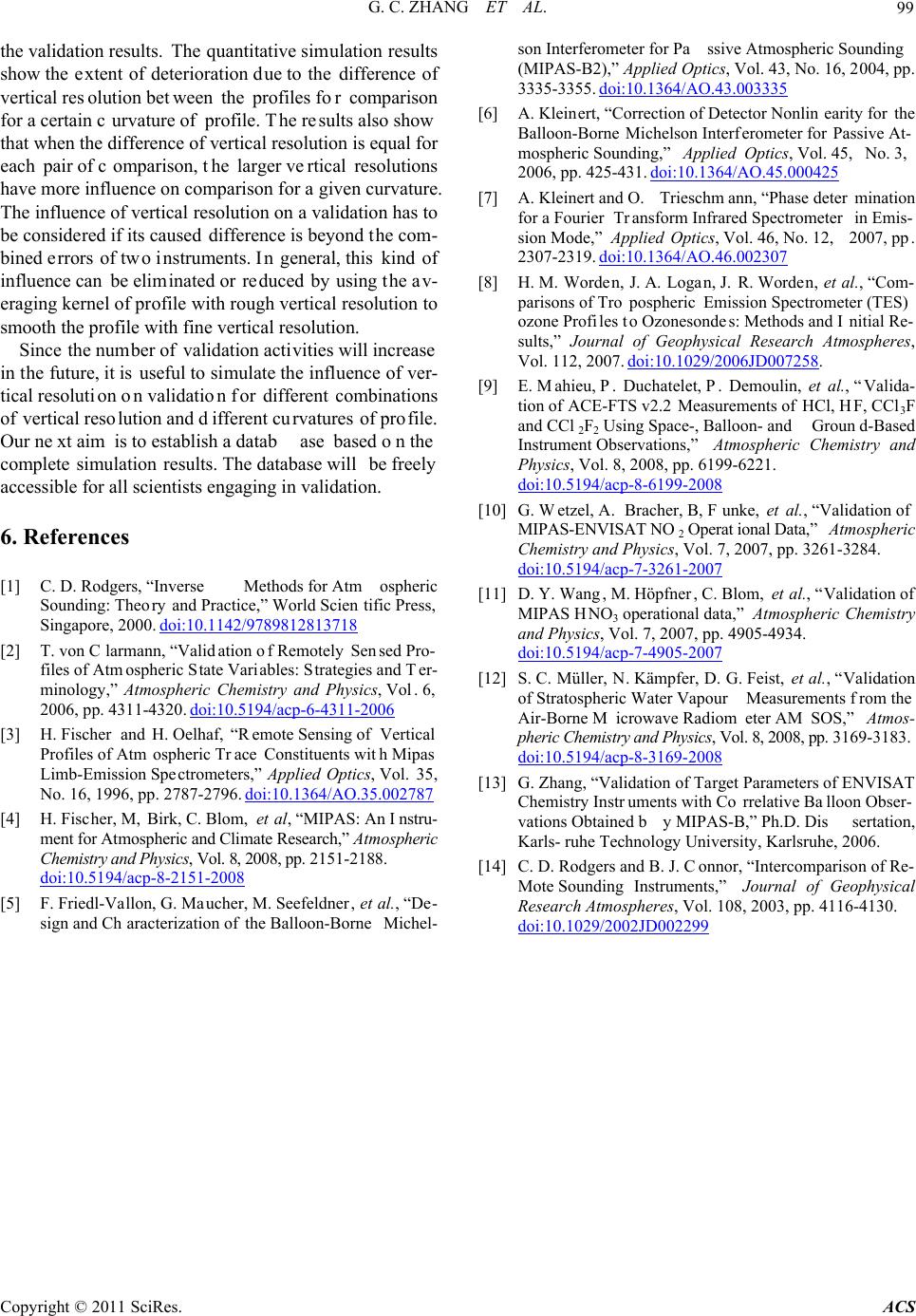
G. C. ZHANG ET AL.
Copyright © 2011 SciRes. ACS
99
the validation results. The quantitative simulation results
show the extent of deterioration due to the difference of
vertical resolution between the profiles for comparison
for a certain c urvature of profile. The results also show
that when the difference of vertical resolution is equal for
each pair of comparison, the larger vertical resolutions
have more influence on comparison for a given curvature.
The influence of vertical resolution on a validation has to
be considered if its caused difference is beyond the com-
bined errors of two instruments. In general, this kind of
influence can be eliminated or reduced by using the av-
eraging kernel of profile with rough vertical resolution to
smooth the profile with fine vertical resolution.
Since the number of validation activities will increase
in the future, it is useful to simulate the influence of ver-
tical resolution on validation for different combinations
of vertical resolution and different curvatures of profile.
Our next aim is to establish a database based on the
complete simulation results. The database will be freely
accessible for all scientists engaging in validation.
6. References
[1] C. D. Rodgers, “Inverse Methods for Atmospheric
Sounding: Theory and Practice,” World Scientific Press,
Singapore, 2000. doi:10.1142/9789812813718
[2] T. von Clarmann, “Validation of Remotely Sensed Pro-
files of Atmospheric State Variables: Strategies and Ter-
minology,” Atmospheric Chemistry and Physics, Vol. 6,
2006, pp. 4311-4320. doi:10.5194/acp-6-4311-2006
[3] H. Fischer and H. Oelhaf, “Remote Sensing of Vertical
Profiles of Atmospheric Trace Constituents with Mipas
Limb-Emission Spectrometers,” Applied Optics, Vol. 35,
No. 16, 1996, pp. 2787-2796. doi:10.1364/AO.35.002787
[4] H. Fischer, M, Birk, C. Blom, et al, “MIPAS: An Instru-
ment for Atmospheric and Climate Research,” Atmospheric
Chemistry and Phys ics, Vol. 8, 2008, pp. 2151-2188.
doi:10.5194/acp-8-2151-2008
[5] F. Friedl-Vallon, G. Maucher, M. Seefeldner, et al., “De-
sign and Characterization of the Balloon-Borne Michel-
son Interferometer for Passive Atmospheric Sounding
(MIPAS-B2),” Applied Optics, Vol. 43, No. 16, 2004, pp.
3335-3355. doi:10.1364/AO.43.003335
[6] A. Kleinert, “Correction of Detector Nonlin earity for the
Balloon-Borne Michelson Interferometer for Passive At-
mospheric Sounding,” Applied Optics, Vol. 45, No. 3,
2006, pp. 425-431. doi:10.1364/AO.45.000425
[7] A. Kleinert and O. Trieschmann, “Phase determination
for a Fourier Transform Infrared Spectrometer in Emis-
sion Mode,” Applied Optics, Vol. 46, No. 12, 2007, pp.
2307-2319. doi:10.1364/AO.46.002307
[8] H. M. Worden, J. A. Logan, J. R. Worden, et al., “Com-
parisons of Tropospheric Emission Spectrometer (TES)
ozone Profiles to Ozonesondes: Methods and I nitial Re-
sults,” Journal of Geophysical Research Atmospheres,
Vol. 112, 2007. doi:10.1029/2006JD007258.
[9] E. Mahieu, P. Duchatelet, P. Demoulin, et al., “Valida-
tion of ACE-FTS v2.2 Measurements of HCl, HF, CCl3F
and CCl2F2 Using Space-, Balloon- and Ground-Based
Instrument Observations,” Atmospheric Chemistry and
Physics, Vol. 8, 2008, pp. 6199-6221.
doi:10.5194/acp-8-6199-2008
[10] G. Wetzel, A. Bracher, B, Funke, et al., “Validation of
MIPAS-ENVISAT NO2 Operational Data,” Atmospheric
Chemistry and Physics, Vol. 7, 2007, pp. 3261-3284.
doi:10.5194/acp-7-3261-2007
[11] D. Y. Wang, M. Höpfner, C. Blom, et al., “Validation of
MIPAS HNO3 operational data,” Atmospheric Chemistry
and Physics, Vol. 7, 2007, pp. 4905-4934.
doi:10.5194/acp-7-4905-2007
[12] S. C. Müller, N. Kämpfer, D. G. Feist, et al., “Validation
of Stratospheric Water Vapour Measurements from the
Air-Borne Microwave Radiometer AMSOS,” Atmos-
pheric Chemistr y and Physics , Vol. 8, 2008, pp. 3169-3183.
doi:10.5194/acp-8-3169-2008
[13] G. Zhang, “Validation of Target Parameters of ENVISAT
Chemistry Instruments with Correlative Balloon Obser-
vations Obtained by MIPAS-B,” Ph.D. Dissertation,
Karls- ruhe Technology University, Karlsruhe, 2006.
[14] C. D. Rodgers and B. J. Connor, “Intercomparison of Re-
Mote Sounding Instruments,” Journal of Geophysical
Research Atmospheres, Vol. 108, 2003, pp. 4116-4130.
doi:10.1029/2002JD002299